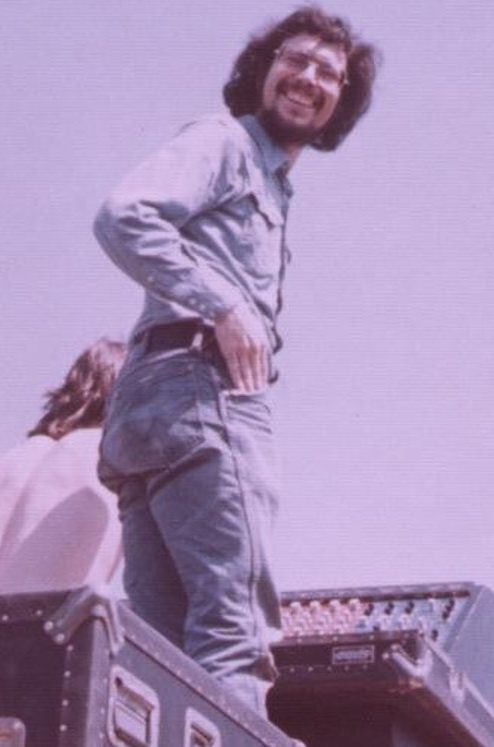
The Omnipressors (1973 & 1974) — A Tale of Two Richards — Factor and Nixon
It’s 1973 and Richard Factor is thinking about how compressors and limiters are used in the studio solely for utilitarian purposes and wonders: Could a device be designed to create dynamic effects? Richard recalls a conversation that he had with Dr. Mark Weiss, an audio expert who was later asked to investigate the infamous 18-minute gap in an Oval Office recording that was at the center of Richard Nixon’s impeachment inquiry. Factor recalls Dr. Weiss describing a ‘homomorphic filter’ and is inspired to create a “dynamics modifier.” Here’s Richard recalling his thinking in the invention of this groundbreaking technique during an episode of the Gear Club podcast.
Inventing the “Side Chain”
A fundamental innovation of the Omnipressor is the technique that has become known as the ‘side chain.’ Dedicated compressors combined an audio level detector and a VCA (Voltage Controlled Amplifier) connected to the same signal input. Richard had the thought that those two functions could be separated such that one audio source could be applied to the level detector and the level detector’s output could be used to control the level of a different audio source or sources. In other words, a smash on the tom tom could squish the level of the vocal, or vice versa. Combining that innovation with the notion of designing a flexible, general-purpose device that could realize a wide range of dynamics processes such as compression, expansion, and gating, Richard got to work building a prototype.
His first prototype was a ‘one off’ shown in Sound Exchange Studio in 1972 in New York City. (Note the “edgewise” meter and the misspelled name!)

The DBX Connection
The side chain was made feasible by products from another new company, Dave Blackmer’s DBX. Although Dolby noise reduction reigned supreme at the time, DBX introduced a line of products that performed complementary compression and expansion, thus cutting in half the dynamic range required for the recording medium, inevitably magnetic tape. At the hearts of each DBX channel were the RMS level detector and Voltage Controlled Amplifier, each a sealed black module. These could be purchased separately, and for the first Omnipressor, they were used with control circuitry to achieve the gate to infinite-compression gamut. By the time the Black-Meter Omnipressor was introduced a couple of years later, the DBX VCA had shrunk in size and price. Also, an interesting substitute for the level detector—a chip with four logarithmic amplifier sections that could be cascaded for a 120dB detection range—became available. This chip made it possible to improve the performance of the system and, even more critically, made it predictable.
The White Meter Omnipressor Model 2826

After demoing the prototype, Richard designed the Model 2826 Omnipressor which Eventide introduced in 1973. In the Instruction Manual Richard explained that it is not a ‘normal’ limiter or compressor but is instead “a special effects unit.” Richard understood that he was onto something new and strange. The instruction manual distinguishes it from the typical compressors and limiters that were used at the time by explaining that the unit “is not normal,” “not simple” but “Rather, it is a special effects unit.”

Often engineers who tried to use the 2826 were puzzled about what it might do and frustrated when they tried to use the controls. Recognizing that this strange device had a significant learning curve, the Applications section starts with a plea:
“Your Omnipressor Loves You and Wants to be Your Friend… please read this Applications section before blaming your Omnipressor for malfeasance or deviltry.”

The Omnipressor’s functionality was illustrated by a graphic that highlighted the “unusual capabilities of the unit.” And what to do when a “return to normalcy is desired.”

The Black Meter Omnipressor (1974) Model 2830

Although the Model 2826 claimed that it wanted to be your friend, most folks didn’t find it so. It was perplexing and the controls fell decidedly short of intuitive.
Enter Jon D. Paul, a degreed engineer and skilled analog designer. Richard had met Jon at Federal Scientific, also the then-employer of Dr. Weiss. Jon took the lessons learned from the white meter version and designed a fully calibrated version with controls that made sense, the black meter Omnipressor, Model 2830, introduced in 1974.
Here’s Jon at the console during a Jefferson Airplane concert in New York’s Central Park:

Eventide touted Jon’s improvements referring to “Calibration” as an “added bonus.”

Inventing Dynamic Effects
As described above, the Omnipressor was designed to be a “a special effects unit” and it lived up to that description. The unit was embraced by creative artists and used on countless records. We called the groundbreaking approach going ‘open-loop’ as described here:
The Instruction Manual described several of the new effects made possible by this novel design.

Infinite Compression
The Omnipressor’s 60dB dynamic range and controllability made infinite compression possible. Input signals of any level would all be output at the same level as illustrated by this cartoon.

Dynamic Reversal
The Omnipressor introduced engineers, producers, and musicians to a new type of audio modification—dynamic effects. The first Application Note described a truly groundbreaking technique as “Your Backwards Omnipressor.” Small signals get large, and large signals get small as illustrated by this cartoon.

The Application Note cautions that trying to use this technique on certain tracks “will generally meet with ignominious failure.”

The application note went on to point out “If you can make forward things sound backwards, you should be able to make backward things sound forwards!”

Predicting “Predictive Compression”
The application note predicted a technique that is commonplace today but required the use of delay to achieve. Compressors and limiters have the inherent problem of handling signals with fast attack transients. This problem can be solved by combining the “unique” technique of side chaining and delay as shown in this App Notes block diagram. The first Omnipressor measures the input signal and controls the gain of a second Omnipressor which acts on a delayed version of the input signal. The audio is “held off” (delayed) until the first Omnipressor decides what to tell the second Omnipressor to do. The result is that fast attack transients can be squelched.
Application Note 5 described using delay and the Omnipressor’s side chain to create “a very close approximation to the ideal compressor.”

It goes on to say “Equipment necessary to realize “predictive compression” has only recently become available.” That would be an Eventide DDL of course!

Test Procedure
1974 was approximately a decade before personal computers were used for design or documentation. Schematics, documentation, test procedures all were created using typewriters, pencils and erasers. Here’s an example of a handwritten test procedure:

The Poster
Model 2830 (black meter) Poster

Omnipressor Deep Dive
Click here for everything we could find in our archives about the Eventide Omnipressors, and be sure to watch this vintage British audio commercial showcasing the many sounds the original Omnipressor could make:
Stay tuned for our next flashback — the H910 Harmonizer!
The Plug-in

“If you want a compressor with bags of pump, depth and character then look no further.”
— Pro Tools Expert
“The most twisted, aggressive, nasty, and yes, seductively versatile dynamics control device I’ve used”
– Harmony Central
Watch Richard demo the Omnipressor Plug-in:
Check out our previous flashbacks!
- Flashback #1: The Instant Phaser
- Flashback #2.1: The DDL 1745 Delay
- Flashback #2.2: The DDL 1745A Delay
- Flashback #2.3: The DDL 1745M Delay
- Flashback #3: The Omnipressor®
- Flashback #4.1: The H910 Harmonizer®
- Flashback #4.2: H910 Harmonizer® — The Product
- Flashback #4.3: H910 Harmonizer® — “Minds Blown”
- Flashback #5: FL 201 Instant Flanger
- Flashback #6: HM80 — The Baby Harmonizer®
- Flashback #7.1: The H949 Harmonizer®
- Flashback #7.2: H949 Harmonizer® — The New One
- Flashback #7.3: H949 Harmonizer® — Bending, Stretching, and Twisting Time
- Flashback #8: H969 Harmonizer®
- Flashback #9.1: Broadcast
- Flashback #9.2: Dump & Go – The Profanity Delay
- Flashback #10: Thinking Outside the Black Box


